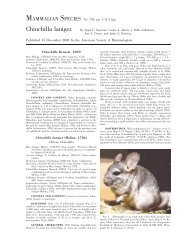Brugia Malayi - Clark Science Center - Smith College
Brugia Malayi - Clark Science Center - Smith College
Brugia Malayi - Clark Science Center - Smith College
Create successful ePaper yourself
Turn your PDF publications into a flip-book with our unique Google optimized e-Paper software.
ChucK and the Keyboard Instruments Project<br />
Lucy Chikwetu<br />
Gone are the days when one had to wait for a day when thunder strikes, or a day when rain pours in order to record lightning or<br />
rain sounds. Digital music synthesis is enabling us to generate sounds when we need them. It is possible to make brass and clarinet<br />
compositions without touching either of those instruments. For six weeks of my summer, I was part of a team helping Professor<br />
Judy Franklin design a new computer science class that we believe will attract more women into the field. It is a course on digital<br />
sound synthesis using a computer music language called ChucK. We were also looking for other ways ChucK could be used in our<br />
daily lives. “ChucK it to the dac, just ChucK it to the dac!” 1 became the song that we belted every time we wanted to take a break<br />
from programming and research in our laboratory, and ChucK it became a solution to all the problems we did not know. 2<br />
As part of our research, we had to understand the basics of sound, analog and digital sound recording, playing back sound,<br />
and digital sound synthesis methods. We had to synthesize our own sounds, look for ways ChucK has been used so far, and think<br />
of new ways to use it. Through the process came the discovery of using ChucK with keyboards, joysticks, and many other devices.<br />
That was a turning point of our work. I believed we could turn our keyboards into musical instruments. We could have our<br />
computer keyboards play sounds from a wide range of instruments such as the piano, clarinet, or brass. If we could do the project<br />
really well, the software could be distributed to various people, especially those who might not have the financial means to buy<br />
musical instruments, yet love music. The project was named the KINS Project. KINS stands for Keyboard Instruments. The basic<br />
components of our work are now functional, and other student researchers are carrying on this research. Below is the Graphic<br />
User Interface (GUI) of our project. The user simply selects the instrument to play and then types on her computer keyboard.<br />
The mapping is chromatic, using two octaves, and the “qwerty” row as the black keys on the piano.<br />
In parallel we worked on course material that could help students who will take the class, including introductory examples,<br />
and slides shows. It was probably not supposed to be that much fun; but that is what always happens when scientists connect<br />
with their research and see what they do not only as a job, but as a way to make a difference. (Supported by the National <strong>Science</strong><br />
Foundation)<br />
Advisor: Judy Franklin<br />
References:<br />
1 A dac is a digital-to-analog converter, used to send sound out to the headphone or speaker port.<br />
2 The ChucK language uses an operator, =>, that is called the “ChucK it” operator.<br />
2012<br />
89

















